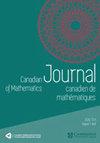How robustly can you predict the future?
IF 0.7
3区 数学
Q3 MATHEMATICS
Canadian Journal of Mathematics-Journal Canadien De Mathematiques
Pub Date : 2022-08-20
DOI:10.4153/S0008414X22000402
引用次数: 1
Abstract
Abstract Hardin and Taylor proved that any function on the reals—even a nowhere continuous one—can be correctly predicted, based solely on its past behavior, at almost every point in time. They showed that one could even arrange for the predictors to be robust with respect to simple time shifts, and asked whether they could be robust with respect to other, more complicated time distortions. This question was partially answered by Bajpai and Velleman, who provided upper and lower frontiers (in the subgroup lattice of $\mathrm{Homeo}^+(\mathbb {R})$ ) on how robust a predictor can possibly be. We improve both frontiers, some of which reduce ultimately to consequences of Hölder’s Theorem (that every Archimedean group is abelian).你对未来的预测有多准确?
哈丁和泰勒证明了在实数上的任何函数——甚至是不连续的函数——都可以仅根据其过去的行为,在几乎每一个时间点上被正确地预测。他们表明,人们甚至可以安排预测器对简单的时移具有鲁棒性,并询问它们对其他更复杂的时间扭曲是否具有鲁棒性。Bajpai和Velleman部分回答了这个问题,他们提供了关于预测器可能有多鲁棒的上下边界(在$\ mathm {Homeo}^+(\mathbb {R})$的子群格中)。我们改进了这两个领域,其中一些最终归结为Hölder定理(即每个阿基米德群都是阿贝尔群)的结果。
本文章由计算机程序翻译,如有差异,请以英文原文为准。
求助全文
约1分钟内获得全文
求助全文
来源期刊
CiteScore
1.80
自引率
0.00%
发文量
58
审稿时长
4.5 months
期刊介绍:
The Canadian Journal of Mathematics (CJM) publishes original, high-quality research papers in all branches of mathematics. The Journal is a flagship publication of the Canadian Mathematical Society and has been published continuously since 1949. New research papers are published continuously online and collated into print issues six times each year.
To be submitted to the Journal, papers should be at least 18 pages long and may be written in English or in French. Shorter papers should be submitted to the Canadian Mathematical Bulletin.
Le Journal canadien de mathématiques (JCM) publie des articles de recherche innovants de grande qualité dans toutes les branches des mathématiques. Publication phare de la Société mathématique du Canada, il est publié en continu depuis 1949. En ligne, la revue propose constamment de nouveaux articles de recherche, puis les réunit dans des numéros imprimés six fois par année.
Les textes présentés au JCM doivent compter au moins 18 pages et être rédigés en anglais ou en français. C’est le Bulletin canadien de mathématiques qui reçoit les articles plus courts.

 求助内容:
求助内容: 应助结果提醒方式:
应助结果提醒方式:


